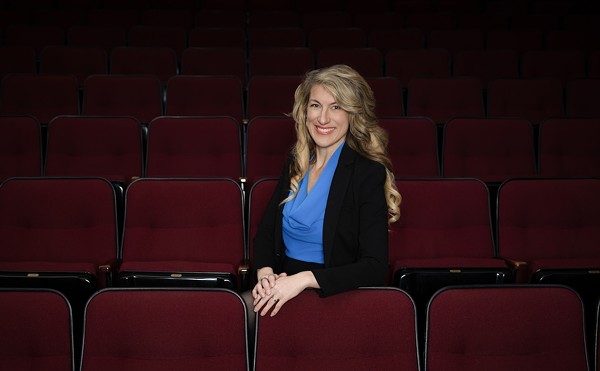Lasker was fortunate that he had as teachers Richard Artschwager and Susan Rothenberg. Lasker said in a 1997 interview that Artschwager "was a big influence on how to think about two-dimensional imagery," and Rothenberg "was one of a number of painters at that time in New York who were dealing with issues of how to re-engage with picture-making."
Lasker also had a generation of minimalist forebears from which to glean, artists such as Robert Ryman, Brice Marden and Frank Stella. They had discovered new possibilities by thinking of painting in terms of its most basic elements: color, line, texture and form.
Lasker had something else going for him: considerable moxie. This can never be overemphasized. The defensive position he maintained to survive Cal Arts and the brief death-of-painting era transformed to boldness as he matured, resulting in epigrammatic counterclaims for painting. "Painting always refers back to its own constituent materials," he writes in his essay "Sleep and Poetry: The Consciousness of Animals." "As such, it is as close as culture ever gets to nature." In his 1997 interview with Ann Hindry, he elevates painting to a pantheon that distinguishes it from recent technological media: "Almost all other media we have are rather transparent. You go right through the medium into the illusion: film, photography, etc. ... transparent illusionism. Whereas painting gives you the body as well. Your own body. It restores you to your existential moment. On that level, there's a critique inherent in painting of all the other media."
This sounds grandiose, or even silly, but artists who think this way are more apt to make art of significance than those who don't think at all. Without such confidence, the result is what most art is: the blind industry of ants.
Lasker's boldness is evident in his paintings, where it matters most. Lasker's Selective Identity, an exhibition of paintings from the '90s curated by David Moos, hangs on the first- and third-floor galleries of the Forum for Contemporary Art. The work enlivens the space with bright color, the intricacy and puzzlement of line, the mystery of form.
Lasker's paintings have been clearly thought through by the artist before execution, and a selection of small studies on paper made in preparation for larger works are on exhibit as well. He is not an "action painter" by any means (an ill-used phrase anyway; the late Willem de Kooning, who was lumped in with this movement, was the most methodical of mark-makers). Lasker shows how exacting execution brings about visual excitement. "Hermeneutic Picture," for example, from 1994, contains a fury of black tangled lines on a pink background making up the top half of the picture. Beneath this, Lasker presents another movement (a visual rhythm is present in these paintings that is reminiscent of musical compositions), boxes of lines going vertically, horizontally and diagonally. To the right of this is a blooming, ghostly form that contains within it petals of orange, green and purple pigment. Playing counterpoint to this form is a similar shape in the lower left quadrant of the painting made of another storm of line, with a dramatic black line slashing through it.
The composition of "Hermeneutic Picture" is exacting and precise, yet without a static rigidity. Lasker is not an action painter, but these are highly active paintings. "There is no resolution in my paintings," Lasker has said, and it is their very irresolution that gives them life.
The title work of the exhibition Selective Identity appeared at the Forum before in a show of contemporary abstract painters. It is good to have it here again, especially as it is placed on a small wall separate from the larger third-floor gallery space. Lasker likes tasty, if not tasteful, colors. "Selective Identity" has a rich purple background on which three black squares of lines counter each other with contrasting diagonal movements. Two spectral forms work to both anchor and elevate the painting -- tangles of yellow line made with thick pigment over a cauldron of red and black.
Lasker's line patterns are reminiscent of Jasper Johns, but without the pretension. His flashy colors are reminiscent of pop art without the iconography. There are an exuberance and playfulness to Lasker's work that belie its studied composition, proving that reports of the death of painting were seriously exaggerated.
In the small alcove space of the Forum, running concurrently with Lasker's Selective Identity, is Jane McAdam Freud's Resonating, a collection of objects contained in glass vitrines. Curator Mel Watkin writes in the accompanying brochure of how McAdam Freud "studied medallic arts from master craftsmen at the Scuola dell' Arte della Medaglia in Rome." But, being an artist with postmodern sensibilities, McAdam Freud "began to investigate -- literally deconstruct -- the medal by breaking it down into its various components."
Resonating shows the results of some of those investigations. In one vitrine McAdam Freud has paired discus objects she has constructed with small collected antiquities. "Decoration of the Rim," for example, is a round bronze object with a pattern of four triangles barely meeting at a point in the center paired with what has been labeled as a "circular pottery stamp with cruciform decoration: Egyptian 1000 BC."
In another vitrine are more paired objects. "Comparing" is another "Decoration of the Rim" medallion paired with a military medal. "Recalling" is the bronze cast of a folded Coke can, green with a snakeskin-textured surface, next to a small box containing a real folded snakeskin. There are more vitrines of bronzed Coke cans, and one with a large catalog that shows objects McAdam Freud has documented like an archaeologist of contemporary artifacts.
McAdam Freud's Resonating becomes a series of questions about what has weight and what has value, what is deemed significant and how significance is rendered in society.
Putting it in a vitrine could be the answer. The obviousness of these investigations diminishes the pleasure of the objects themselves.
Selective Identity and Resonating continue at the Forum for Contemporary Art through Nov. 6.





